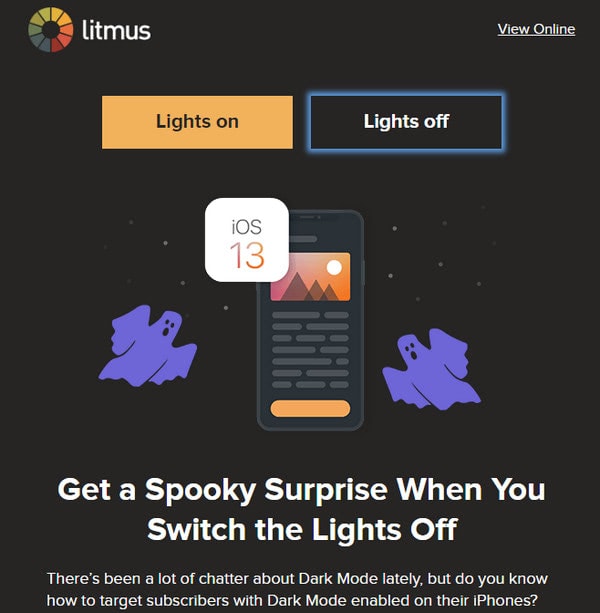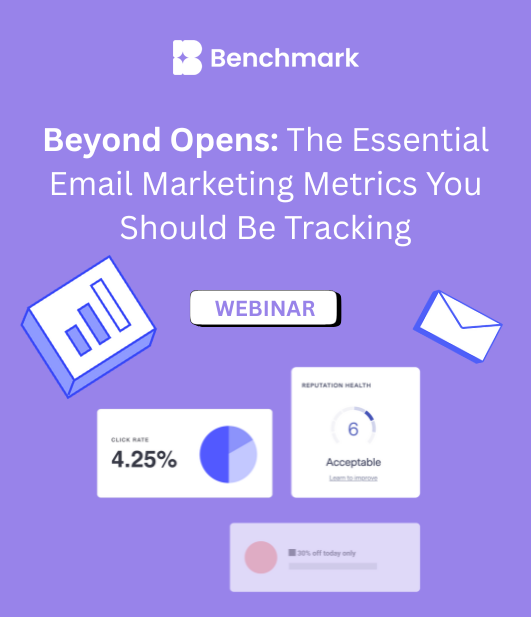The Future of Email Marketing: Trends and Predictions for the Years to Come
November 12, 2025 7 min read

This blog post was last updated on 11/12/25.
Email marketing has long been a staple of digital marketing, but it’s an ever-evolving field that requires businesses to stay up-to-date with the latest trends and technologies. But with things changing so often, staying up to speed is a job in and of its own.
In this article, we’ll explore the current state of email marketing, emerging technologies that will impact the industry, and strategies for staying ahead of the game.
Why staying up to date with email marketing trends matters
Here’s the thing: if you’re not keeping up with email marketing trends, you’re basically emailing into the void. The good news? There’s always time to level up your game. The better news? We’ll show you how.
Skip the trends, and you’ll miss out on better engagement, higher conversions, and frankly, easier wins.
Staying up to date with email marketing trends also shows a commitment to continuous learning and improvement. The world of email marketing is constantly evolving, and by staying up to date with the latest trends and best practices, marketers can continually refine their skills and adapt to new challenges.

Predictions for the future of email marketing
Ready for a peek into email marketing’s crystal ball? Here are some things on the horizon for email marketing.
1. More advanced personalization
Personalization will remain a key trend in email marketing, with marketers leveraging data and machine learning to create even more targeted campaigns. Think of machine learning as your email marketing sidekick—it spots patterns in your data and predicts what your subscribers actually want to see.
For example, machine learning can be used to analyze customer data and identify patterns in their behavior, such as the types of products they are interested in or the time of day they are most likely to engage with emails. This information can then be used to tailor email content and timing to increase engagement and conversions.
Machine learning can also be used to automate email campaigns, enabling marketers to create triggered emails sent based on specific customer actions or behaviors, such as abandoning a shopping cart or making a purchase. By using machine learning to predict which customers are most likely to respond to specific email campaigns, marketers can improve campaign effectiveness and increase revenue.
2. Greater use of AI and automation
AI and automation will become increasingly prevalent in email marketing, with marketers using these tools to automate and streamline their campaigns and deliver more personalized experiences to subscribers.
3. Increased focus on privacy and data security
As consumers become more aware of privacy and data concerns, marketers will need to prioritize these issues in their email marketing efforts. Doing so will help them build trust and set the foundation for a long-term relationship with potential customers.
4. More interactive and dynamic emails
Emails will become even more interactive and dynamic with the use of augmented reality, interactive graphics, and other technologies.
5. Continued growth of mobile email
With more and more people accessing email on their mobile devices, marketers will need to prioritize mobile optimization and ensure that their campaigns are optimized for smaller screens.
6. Voice-activated email
Voice-activated email refers to using voice commands or voice assistants to read, compose, and manage email messages. This technology allows users to dictate emails, manage their inboxes, and perform other email-related tasks without typing or physically interacting with their devices.
Voice-activated email is still finding its feet, but savvy marketers are already thinking about what this could mean for their strategy.
For email marketers, this means that it will become increasingly important to optimize email content for voice-activated devices. This could involve using more natural language in email copy, incorporating more conversational language in subject lines, and creating content that is easily digestible through spoken word.
In addition, voice-activated email could open up new opportunities for personalized email experiences. For example, voice assistants could use customer data to provide tailored email recommendations or offer personalized email greetings.

7. Augmented reality
Augmented reality (AR) is an emerging technology that overlays digital information in the real world through a mobile device, such as a smartphone or tablet. In email marketing, AR can create interactive, engaging experiences for subscribers.
One example of how AR could be used in email marketing is by allowing subscribers to try on virtual clothing or accessories before making a purchase. Another example is providing 3D product visualizations that let subscribers view products from different angles.
The potential for AR in email marketing is vast, but it is still a relatively new technology, and there are some challenges to overcome, such as the need for specialized software and devices. However, as AR technology continues to improve and become more accessible, we are likely to see more brands incorporate it into their email marketing strategies.
One of the benefits of AR in email marketing is its ability to deliver a unique, memorable customer experience. By creating interactive and engaging experiences, brands can build stronger connections with their subscribers and increase engagement rates.
In addition, AR can increase conversion rates by allowing subscribers to see products in a more realistic, immersive way, helping them make more informed purchasing decisions.
The bottom line? Email marketing is getting smarter, not more complicated—and that’s exactly how we like it.
Trends in email marketing
To stay ahead in email marketing, it’s essential to understand current trends and best practices. This section will cover some of the most significant trends in email marketing, such as personalization and segmentation, interactive emails, automated campaigns, and mobile optimization.
1. Personalization and segmentation
Personalization and segmentation are becoming increasingly important in email marketing. By segmenting your audience and personalizing your emails, you can create more targeted and relevant campaigns that resonate with your subscribers.
When segmenting your email list, you can create lists based on the following characteristics:
- Industry
- Region
- Job title
- Where they are in the buyer’s journey
- Purchase history
- The content they’ve downloaded

Smaller List, Bigger Impact: Why Removing Unengaged Subscribers Boosts Email Performance
DOWNLOAD NOW2. Interactive emails
Interactive emails, such as those with embedded videos or animations, are becoming more popular. These types of emails can increase engagement and provide a more immersive experience for subscribers.

3. Automated campaigns
Automated campaigns, such as welcome series and abandoned cart emails, are becoming more common. These campaigns are automatically deployed based on subscriber actions, such as signing up for a brand’s email newsletter or abandoning a purchase. They can help to streamline the email marketing process, improve ROI, and provide a more personalized experience for subscribers.
4. Mobile optimization
As more people access their email on mobile devices, email campaigns must be optimized for mobile screens. This includes using responsive design and creating shorter email subject lines and copy.
5. User-generated content
User-generated content, such as reviews or social media posts, can be incorporated into email campaigns to increase authenticity and engagement. This also shows potential buyers how happy and engaged your customers are, which can encourage purchases and more sales.
Strategies for staying ahead in email marketing
Staying ahead with email marketing is a constant process. Here are some tips that will help you keep up.
- Read up and attend events: Follow industry blogs, attend conferences and webinars, and read reports to stay informed about new developments in email marketing.
- Experiment with new technologies and strategies: Don’t be afraid to try new things and experiment with new technologies and strategies. This can include things like interactive emails, personalization, and automation.
- Segment your audience: Segment your audience based on behavior, demographics, interests, and other relevant factors. This will allow you to create more targeted and relevant email campaigns.
- Test and measure results: Continuously test and measure the results of your email campaigns to identify what’s working and what’s not. Use this data to make adjustments and optimize your campaigns.
- Focus on mobile optimization: As more people access their email on mobile devices, your email campaigns must be optimized for mobile screens.
- Use data and analytics: Use data and analytics to understand your subscribers’ behavior, preferences, and needs. This will allow you to create more targeted and personalized email campaigns.
- Create a seamless customer experience: Ensure your email campaigns align with the rest of the customer journey and provide a seamless experience for subscribers.

The future of email marketing and the customer experience
The future of email marketing and the customer experience will be about creating a seamless, personalized experience for each subscriber. As mentioned earlier, personalization and segmentation will remain major trends in email marketing. Marketers will need to use data and analytics to understand their subscribers’ behavior, preferences, and needs to create targeted, relevant email campaigns.
Ultimately, the future of email marketing and the customer experience is about using data and technology to create a personalized, seamless experience for each subscriber. By understanding subscriber behavior and preferences and leveraging automation and interactive features, marketers can create targeted, relevant email campaigns that drive engagement and, ultimately, revenue.
To succeed in email marketing, businesses must stay up to date with emerging trends and technologies, test and measure results, and prioritize the customer experience. Marketers need to start planning for the future of email marketing and invest in their skills and education to stay ahead of the game. Good luck!
Frequently asked questions
Got questions about the future of email marketing? We’ve got you covered. Check out our most commonly asked questions below—or reach out if you don’t see your answer here!
Q: What are the 5 T’s of email marketing?
A: Tease, target, teach, test, and track—an easy framework that keeps campaigns reader-first and results-driven.
Q: What is the 80/20 rule in email marketing?
A: Focus 80% of effort on the 20% of subscribers who drive most results, and keep messages 80% helpful content and 20% promotion for happier readers and higher ROI.
Q: What is the 60/40 rule in email?
A: The 60/40 rule says keep roughly 60% text and no more than 40% images in every email. That balance makes messages load faster, keeps spam filters happy, and ensures your words still show if pictures are blocked. A quick check—write at least 400 characters of text before you press send.
Benchmark Recommends
See all articles
How to Segment Your List for Holiday Sales (Without the Headache)
The Rise of ‘Inbox Fatigue’ and How Smart Marketers Are Responding
A powerfully simple email marketing platform
Sign up for free to see how effortless email marketing can be.
Our Company
Compare
Solutions
Compare
Account
© Polaris Software, LLC 粤ICP备14001834号 Benchmark Email® is a registered trademark of Polaris Software, LLC
© Polaris Software, LLC 粤ICP备14001834号
Benchmark Email® is a registered trademark of Polaris Software, LLC



